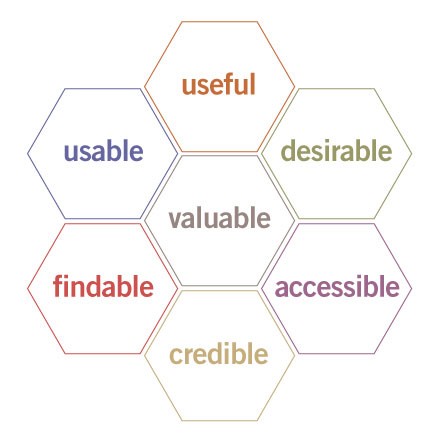Customer value asks the question, “Is it worth your customer’s time to visit your website?” Do you deliver the information they need in the way they can best use it? When applying customer value to your website, you consider usability questions, but you also look beyond usability to the large questions of user experience.
User experience expert Peter Morville developed a “User Experience Honeycomb” to help illustrate the various aspects of user experience (UE). Morville suggests that when users engage a webiste, they are engaging it on multiple levels, and each of the following areas describes an aspect of their overall experience:
- Useful
- Usable
- Desirable
- Findable
- Accessible
- Credible
The above six aspects circle around the bigger question of customer value.
Useful – When customers engage with your company online, do they find it useful? It is essential to to understand who the customer is and what they need, in order to answer the question of usefulness. Your content should meet the need, so they return again and again.
Usable – When customers do visit the website, can they find what they are looking for easily? Does website speak in their vernacular? It is important to speak to customers in the way they think and speak.
Desirable – How does your site make customers feel? This may seem like an esoteric question, but it connected to a larger customer value proposition known as emotional design. It asks, “Why do customers love the products or brands that they love?” Customer-centered design focuses on how design, image, identity, and brand evoke emotion and appreciation.
Findable – Similar to usability, find-ability focuses on making it easy to find what customers are looking for. This can be applied on your site and in other places on the web. Where do your customers go online? When creating content, you might also ask where are the best places online for customers to find this content? With this question, you could begin developing a broad-reaching content strategy that meet customers where they are at.
Accessible – Is the website easy to use for customers with disabilities? If customers access website from various sized wireless devices, is it easy to use?
Credible – Can customers trust your claims? Stanford has developed an entire research arm focused on web credibility (for insights from their research review the Stanford Guide for Web Credibility).
All these questions contribute to the larger question of value. Is the website valuable? Is it worth visiting and revisiting? You could actually apply these aspects to your overall communication strategy with your customer. If your messaging does not deliver customer value then no matter how clever or how clearly it proclaims your products or services, it will fail to connect.
Source: User Experience Honeycomb by Peter Morville





